(What follows is Joseph Lubin's speech to the 2019 Deconomy Conference in Seoul. Lubin is the founder of Consensys, a Brooklyn, NY-based incubator that funds DecryptMedia, which is editorially independent. We requested a draft of the speech because we thought it was sufficiently newsworthy to republish, in full, here.)
The Economic Ages
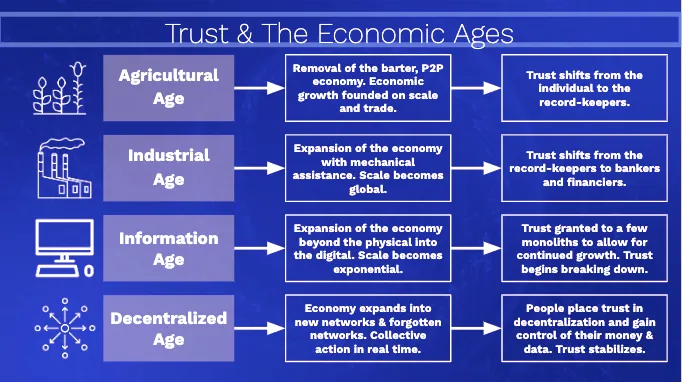
Every modern economic age has been driven by an explosion of technological innovation that increases efficiency and coordination.
During the industrial revolution, steam power, and other forms of mechanical assist, force multiplied what we could do with our muscles alone, enabling us operate bigger, better, and faster and to create more value in less time.
The information revolution saw computation machines enable us to process information better and faster, magnifying the complexity that we could contemplate and execute, enabling us to impact broader vistas and create more value in less time.
In 1984, John Gage, chief scientist at Sun Microsystems, coined the phrase, "The network is the computer," and years later many web 1 and web 2 companies brought that network to billions across the world, super charging our gregarious nature, creating the social network / global community revolution—enabling us to act collectively on a global scale in real-time.
Objective Trust
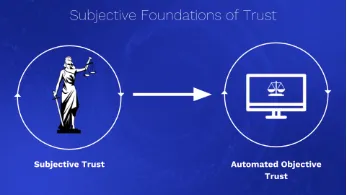
For millennia, humans have built out systems and technologies that have raised the quality of life for so many. But all of these developments have rested on a single somewhat flimsy foundation: the base trust layer of our societies.
People need trust between one another in order to do even the most basic thing together. Thus far all of the base trust layers in our societies have been founded on subjective trust:
-
- trust in a single individual, or
- in interpersonal social networks, or
- in platforms like businesses and institutions, or
- in large centralized authorities, like governments.
This works reasonably well in many situations, but it often breaks down when there is a misunderstanding, information asymmetry, or especially when there is an imbalance of power.
Reliance on centralized trust enables certain kinds of intermediaries to extract too much value from a transaction flow.
They extract these rents largely for imbuing relationships with necessary trust, standing between content creators, service or resource providers and their customers. Up until recently this was the only way we knew how to collaborate at scale on planet Earth. And now we need new and better trust infrastructures on which to rest all of the technology, commerce and political tooling that runs the world.
In blockchain and decentralized protocol systems we have a breakthrough in how we can build trust into all of our systems: Automated objective trust can replace reliance on older weaker forms of subjective trust.
The Trust Revolution will transform everything. We can now rearchitect systems and society enabling guaranteed execution of agreements, and build fidelity, fairness and equitability into the application of societal rule systems, as everything we do can be rebased on a sounder trust foundation.
This emerging revolution in the global trust infrastructure -- enabled by maximally decentralized blockchain and related protocols -- will force multiply everything we do in the age of automated trust. This stage of economic evolution will not only enable us to create orders of magnitude more value in less time, but it is likely to change the very definition of value going forward.
The Trust Revolution

The trust characteristic of blockchain systems derives from their degree of decentralization.
Certain blockchain networks can't be improperly manipulated—can't be cheated, even if up to half of the nodes on those networks are malicious.
If a network like Bitcoin or Ethereum has thousands of nodes, we can be confident that these systems are harder to improperly manipulate than nearly any system in human history.
We would achieve maximal decentralization of a blockchain network if every person on the planet owned precisely one full node device connected to the network.
Proof of work systems are vulnerable to reduction in decentralization at the node network level due to costs of hardware and energy, preferential access to optimal hardware, and efficiencies of scale.
A well designed proof of stake system will remove these asymmetries, enabling more people to own or control hardware on the network. The barrier to entry will be low enough so that nearly anyone will be able to validate transactions on the Ethereum network and help secure it.
Casper proof of stake will bring breakthroughs in scalability while enabling the network to be more decentralized and therefore more secure. Casper on the Ethereum Beacon chain is live on testnets now and the 8 teams building their own implementations of the protocol should be in sync on a shared testnet within a small number of months.
Settlement, Platforms, and Walled Gardens
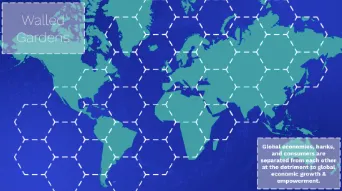
Settlement is the act of finalizing a trade or transaction. When settlement is complete, all parties to the transaction have received what they traded for and are no longer encumbered.
A settlement system, platform or layer is the locus on which settlement of business, trade or transactions occur.
In stock or equity trading, settlement between clients of a brokerage can happen at the level of the brokerage, while other kinds of settlement may need to happen at the base layer. Around the world these are called centralized depositories. In this country it is the Korea Securities Depository.
There doesn't actually exist a coherent global financial system. It is a network of walled gardens: brokerages that serve their jurisdictions; central depositories for each nation; and banks that handle their business nationally and reach out using correspondent banking relationships when they need to cross into another walled garden to complete a transaction.
Settlement of a sort happens on many different kinds of platforms beyond the financial industry. EBay, PayPal, MasterCard and Amazon can be considered settlement platforms for certain kinds of transactions. Google Play and the App Store could also be considered settlement platforms. Travel web sites and Health Maintenance Organizations are still others. None of these focus primarily on benefit to the consumer and many of these play disturbing games with their customers to wring maximal value out of us. Each of these prioritize protection of their pricing power -- limiting freedom, choice, and quality of service for the end user.
The legacy economy is all about creating the deepest, widest moats to protect competitive businesses.
- Service providers, like software and game developers, doctors, musicians, teachers and Uber drivers, also suffer from platform capture in their different industries.
- Software developers have had to deal with various platforms over the decades: AOL, Compuserve, Windows, Mac, the open web with browser compatibility headaches, shrink-wrap stores like CompUSA and Egghead, and now the walled garden web: iOS, various Android systems, Facebook, the App Store and Google Play.
- Throughout history you had to pay some piper to get your work in the hands of users. It is a breath of fresh air that currently on some blockchain platforms, a developer can permissionlessly deploy or use software in seconds for pennies anytime she wants.
- In the gaming space, the platforms on which games had to live -- their "settlement" layer, so to speak -- has always been proprietary, leaving game studios very vulnerable. From the console wars where platforms rose and fell in dominance, to Facebook pulling the rug out on game developers by changing the economics and data access on the platform, to app stores playing the same powerful intermediary role today. Ethereum currently enables a dev studio to bring their own scalability solution, like Loom or Axie Infinity, and anchor it into Ethereum -- a platform that nobody (and everybody) owns. The platform itself won't be taking 30% of your earnings. And it can't change the rules on you to its own selfish economic advantage. This is the maximally fair base platform or "global settlement layer" for the game industry. And as a bonus, it enables unprecedentedly fluid interoperability for digitally scarce game assets between any games that conform to relevant token standards. That is a natural side effect of an open, shared platform.
- Service providers like blockchain companies are at the mercy of financial industry platforms as many software development companies around the world have had difficulty establishing banking relationships, if they are seen to be working with next generation database technology that has some unacceptable degree of decentralization to its architecture. Decentralized finance is coming of age and soon blockchain companies will be less dependent on the legacy financial infrastructure.
Platform Risk
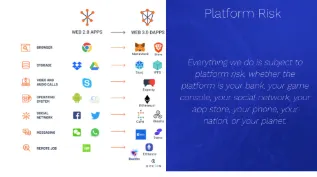
Platform lock-in enables censorship and single points of control or failure in virtually every aspect of the global economy. These silos enable the incumbents to maintain pricing power at the expense of quality of service, cost and choice for the consumer.
Everything we do is subject to platform risk, whether that platform is your bank, your game console, your social network, your app store, your phone, or your country.
Decentralized protocols, for the first time in history, enable self-sovereign humans to manage the root of their own identity using systems like uPort, to control their private information in personal data lockers like 3box, and to engage in self-sovereign employment (on platforms like Gitcoin or Bounties.Network) -- permissionlessly -- on trustworthy platforms like Ethereum.
Fat Layers & Economic Opportunity
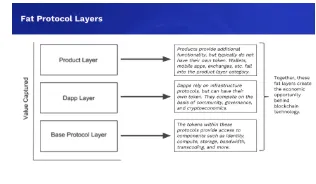
In 2016 Joel Monegro, then of Union Square Ventures, wrote a blog post entitled "Fat Protocols." The idea was that unlike the internet and web —where the protocol layers did not capture value—as the blockchain ecosystem evolves we are likely to see protocols like Ethereum and other web 3.0 protocols for decentralized storage, bandwidth, heavy compute, identity, proof of location, etc., also capturing value, as each will be a tokenized protocol-based open platform.
I prefer a variant of that thesis: the Layered Fat Protocols thesis. And it might be better to call them Layered Collaboration Protocols.
Ethereum is a protocol-based open platform. We have a project called Ujo Music, that is enabling over 1000 artists —and growing 10% month on month—to directly access their fans. They can get paid for their music without an entrenched intermediary sucking up 70% of the value -- as record companies and streaming platforms do.
Soon Ujo will separate its Creator's Portal from an underlying meta-data and DRM platform, tokenize it, and offer it to the world to build on as a permissionless, shared protocol-based open platform for an adjacent music industry. This would be a collaboration protocol on top on Ethereum. And we can layer on other open collaboration protocols: for content curation, ticket selling, equipment leasing, venue rentals, marketing, legal, etc. These industry collaboration layers will likely utilize the base Ethereum trust layer, layer one, as well as layer two technologies like state channels (as Ujo currently does) and other techniques like Plasma networks.
The difference here, between Ujo and whatever gets built on or beside it -- and Sony BMG, Warner, Universal, BMI, ASCAP, Virgin Records, and Ticketmaster, is that anyone will be able to offer their music or build businesses on the Ujo platform. There will be choice for all. And those shared music industry settlement layers will be global. Each of these would be open, permissionless to attach to, and maximally fair within the context of whatever decentralized governance the platform created for itself.
But what if governance gets captured and the platform ceases to work well for most people and businesses on it? Open source platforms can fork at the code level or even at the operating network level, as we have seen in the Bitcoin and Ethereum ecosystems. Forking is a good thing. It enables subcommunities to set out in new directions if the current direction ceases to serve their interest. It is an evolutionary mechanism that enables search of the solution space and it provides us with greater choice. Perhaps most importantly, the threat of forking forces us all to get along better and make compromises to accommodate more viewpoints. As we get better at enabling upgrades or forking of systems, switching costs can become very low, so artists could simply offer their wares on the new platform with ease, perhaps just by checking a box. The initial dream for the internet, that it would see censorship as damage and route around it, might just prevail this time. Of course, we will have to be continuously creative and vigilant.
Vertical Integration

During the internet and early web eras, protocols were indeed monetized. Cisco did a great horizontal job of that. Later on, other protocols (HTTP, SMTP, XMPP) were monetized as part of vertical offerings, by AOL, MSFT, Google, Facebook, Apple, Amazon and others.
Capturing a vertical, through integration from bottom to top, is great for a business, as it ultimately puts them in the role of an intermediary that can extract outsized rents from an ecosystem or expand more easily into related niches. Vertical integration is a key force that drives lock-in and enables walled garden moats. Think Google, Amazon/AWS, Microsoft, Apple, and WeChat.
In the blockchain era, we can monetize protocols in a more horizontal fashion. Layered protocol-based open platforms for various industries and niches can promote more open competition because granularizing their offerings can lower the barriers to entry at each layer. If that happens, there will be less opportunity to leverage success at one layer into success at other layers. This is exactly what competition law or anti-trust law was designed for. Such an architecture for our economy will likely result in more smaller, specialized organizations and more equitable monetization.
Granularization of Global IT Infrastructure
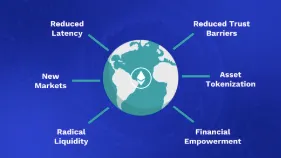
The global IT infrastructure is less a granularized free market economy than, say, the energy, grains, and metals commodity value chains. Many organizations in the IT space still maintain heavy sales forces and operate in 2-sided markets. Products are still effectively shrink-wrapped, whether in boxes, on app stores, or delivered as a service, and we have lock-ins trapping us in walled gardens. While the Apple, MSFT, Amazon, and Google suites of offerings are awesome and have enabled the world to advance rapidly, we can do better. We can build on open platforms that enable greater choice, less lock-in, and less staying and pricing power for large dominating entities.
Cloud compute, storage and bandwidth will move over time to fog and cloud infrastructure as we ask our watch to take care of a task and it provisions resources from clothing, furniture, laptops, and clouds. Legally enforceable blockchain-based agreements, like those enabled by OpenLaw, will enable us to negotiate the distribution of such jobs over a ubiquitous compute, storage and bandwidth fabric. And we'll be able to pay, clear, and settle in real time using protocol tokens.
Next Generation Financial Industry Infrastructure
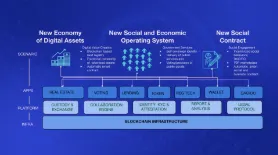
The next generation financial industry infrastructure will consist of centralized and decentralized spot token markets for utility tokens and tokenized securities, atomic swap protocols, price stable tokens, parameterized insurance products and markets on which they will trade, lending platforms, trade finance platforms, insurance platforms, open venture capital platforms, and decentralized governance mechanisms. Futures, options, and other derivatives will enable resource providers to hedge out their price risk, and consumers to provision for their needs at a locked-in price for a certain period of time. All of these exist right now and many are maturing rapidly.
This new infrastructure is being built out to enable the granularization and commoditization of the global IT infrastructure and similar transitions in other industries. We will see free markets get freer: more collaboratively competitive, more efficient and with lower barriers to entry, more equitable. The FinTech / DeFi revolution, enabling all of this, is hockey sticking right now, and most of that is happening on Ethereum.
Closed Platforms = Corruption & Inefficiency
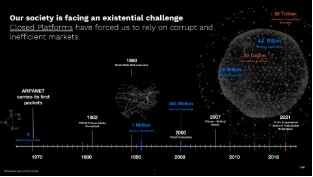
Closed Platforms Promote Corruption and Inefficiency.
The global economy is rife with improper manipulations of markets due to platform lock-in or capture. Even the liquid deep markets of the present economy are regularly corrupted. It has long been the case that well resourced and patient actors have been able to observe market realities and manipulate them for selfish purposes.
In recent years we have seen the gold and silver price fixing scandal involving entities like Barclays and Deutschebank. And even the base rate that sets the price of money around the world, LIBOR, was regularly manipulated by a cabal of banks for selfish purposes. UBS, Barclays, and others paid fines for decades of active corruption of this market.
As we tokenize the world, well-resourced financial houses and traders will spare no effort to manipulate markets for gain or political advantage. We don't want the liquid deep token markets of the next generation economy to be similarly vulnerable. We must not choose anything other than a maximally decentralized base as the foundational settlement layer of the global economy.
The Ecosystem: What are the Choices
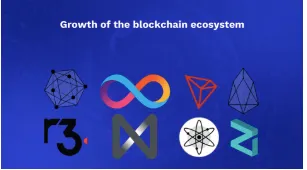
Assuming we agree that freedom, choice, and maximal trust are good things, what would be the optimal choice at this point for a global settlement layer on which we can re-architect our industries and collective endeavors?
- Perhaps IBM's Fabric?
- Nope, there is no chance of it evolving beyond relatively small networks for private, permissioned systems.
- Fabric can issue tokens, but only for narrowly circumscribed situations.
- The Fabric technology promotes platform lock-in.
- R3’s Corda
- R3’s Corda is blockchain inspired software for mostly banking industry applications. It is more about point-to-point trust than a shared source of truth.
- Corda can issue tokens, but only for narrowly circumscribed situations.
- The Corda technology promotes platform lock-in.
- How about EOS?
- As has been debated endlessly, a platform controlled by 21 crypto bros is just not all that decentralized. They can collude and censor if they wish. Governments and other well resourced actors can bribe them or force them to act against their will and against the well-being and security of the people using the platform.
- It has been argued that if these block producers start behaving badly, they will be voted out, and that is the main source of decentralization in the system. Unfortunately, there is no good way for anyone to detect that they are colluding, or have been corrupted or forced into some sort of improper action.
- I can imagine EOS being used for some games, but not even for games that have high value tokens. It will be too easy to organize to steal value on this platform.
- Polkadot
- The Polkadot system is being built by Parity, the developers of the Ethereum Parity client. Parity is a strong team.
- Polkadot will achieve scalability by having one main heartbeat chain -- the relay chain -- with multiple parachains hanging off of it. Polkadot is scheduled to launch its relay chain mechanism in Q3 of 2019.
- The Polkadot worldview sees Ethereum connected as a potential "virtual parachain" via a bridge.
- For any parachain to become attached to the Polkadot relay chain, it must be voted in by the holders of dots -- the Polkadot system token. These voters can also choose to pause a parachain or remove a parachain from the system if it is deemed to be out of compliance with what the majority prefers. Effectively, this is a permissioned system, and white listing and blacklisting of entire parachain networks is a core tenet of the governance system of Polkadot.
- One could imagine a parachain choosing to be permissionless and allowing anyone to upload any dapp, but ultimately the DOT holders might take issue with this, as they might be considered by authorities to be responsible, so it would probably be too dangerous a policy for a parachain to offer. It is likely that this will be a permissioned and highly controlled blockchain platform.
- Cosmos
- Cosmos also has a solid team of technologists.
- Cosmos doesn't really propose a base trust layer. It seems more focussed on enabling different sovereign platforms to interoperate side-by-side. And it doesn't appear that there will be much interoperation between platforms in the next few years beyond enabling tokens to move back and forth across network boundaries. The Cosmos team feels that this will be the main and most important interoperation use case.
- I expect Cosmos to have good utility as a layer two solution, linked into the base trust layer when necessary.
- Cosmos also expects to interoperate with Ethereum through a token bridge.
- Dfinity
- Dfinity has a strong team.
- Because Dfinity is currently a closed system controlled by a small number of investors and token holders -- though they have indicated that they will open source their project at some point -- it is hard to tell, but it appears to me that they are less interested in being a global base trust and settlement layer and more like a somewhat decentralized AWS replacement. They are likely to do a good job of this whenever it gets released.
- Ultimately it does not seem viable for Dfinity to be a base trust layer for the planet as there is one fundamental design choice that they and Cosmos made that will prohibit this. Both Dfinity and Cosmos favor safety or consistency over availability and liveness. This means that if 34% of the nodes on their networks find themselves on the wrong side of some great firewall that blocks traffic for a period, their entire global network will halt, freezing every system built on it. And there are other known related failure modes. This is a non starter for many different classes of application.
- So in my, admittedly somewhat biased opinion, there is only one currently viable option for the base trust layer, the global settlement layer for the planet … Drumroll, please.
- Tron

Ah wait. No. That can't be right.
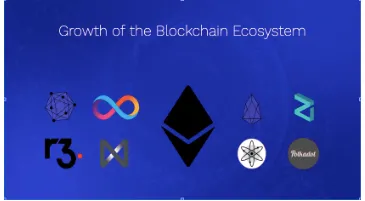
Yes, that looks better.
Ethereum 1.0
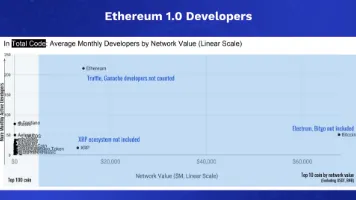
Ethereum is the largest blockchain ecosystem by a variety of measures. In terms of core protocol engineers it is ahead of Bitcoin and both are far ahead of all other systems combined. In terms of application layer developers, Ethereum was estimated by a Gartner analyst to have a developer ecosystem that is 40x larger than that of #2, IBM’s Fabric.
Ethereum is a truly permissionless system. There are no white lists or black lists. Anyone can attach to the network and validate transactions. Anyone can upload applications to Ethereum. It is a censorship-free base trust layer for the planet with no single central point of control or failure.
Ethereum is the largest blockchain ecosystem by a variety of measures and in order for it to continue to grow into the base settlement layer for the planet, we are working on a few things:
- easier user onboarding, UI and UX
- privacy and confidentiality, and
- scalability
Each of these are seeing great strides made.
With respect to user onboarding, projects are doing more handholding of users early in the relationship, not forcing them to remember 12 words forever lest they lose their identities and all of their value tokens. Projects are putting more responsibility on the user later in the relationship when the users are more experienced. Blockchain introduces new modes of operation and just like Apple computer brought users gently up to speed in how we gesture, pinch, swipe and type on the iPhone, we will have to do the same. Product teams like MetaMask, Burner Wallet and 3box are finding ways to create simple and high-value UX to facilitate mass adoption.
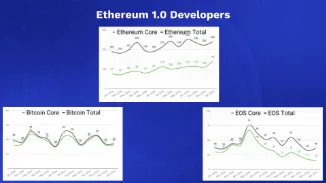
We are also making great strides with respect to privacy and confidentiality either on private networks that can be attached to Ethereum via the Plasma technology for instance, or via state channels, or protocols like Aztec that enable confidential transactions involving any token on public Ethereum.
Ethereum—ERCs
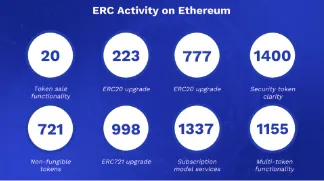
Ethereum is where most of the Web 3.0 standards are being forged. ERC activity on Ethereum is another demonstration of its momentum. Better-known standards such as ERC20 and ERC721 fueled the tokenization activity of the past few years and the growth in games with non-fungible tokens. ERC223 and ERC777 provide upgrades on the ERC20 standard. ERC998 extends the utility of ERC721s. ERC1337 allows for blockchain-based subscription payments. ERC1400 provides clarity for security tokens. ERC1155 will enable multi-token functionality. And those are just to name a few.
Ethereum—Momentum
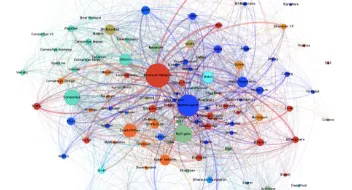
Ethereum 2.0, Polkadot and Dfinity have similar architectures and capabilities and are likely to arrive at around the same time, though my best is on Serenity (Ethereum 2.0) to be fully functional and in use by many earlier than this next generation of architectures. Architecting and building a platform requires an enormous amount of work, but launching a working platform is also a huge effort. The Ethereum ecosystem has the diversity, expertise and momentum to get this done well and quickly. It takes an enormous amount of work and network effect to build an ecosystem, so by that time, Ethereum's ecosystem will be orders of magnitude larger than the other two and will already have strong scalability at layer 2.
Ethereum is innovating fast with respect to scalability at both layer two and layer one. And layer one is the only current candidate to be a base settlement layer for the planet because it favors availability and liveness over consistency, bolstered by relatively fast finality, and the project is the most rigorous of any out there about being maximally decentralized.
Quantifying Decentralization
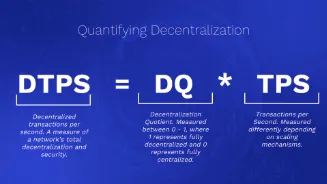
How to assess that decentralization, however - and consequently how to value one blockchain’s potential over another - is a more involved conversation.
Much discussion focuses on a blockchain’s scalability, measured by transactions per second. This isn’t the best way to measure a blockchain’s throughput, as it ignores the important aspect of decentralization. We instead propose DTPS, or Decentralized Transactions per Second -- meant to objectively compare blockchains’ performance and potential by quantifying decentralization along with throughput.
DTPS is the product of Transactions Per Second and DQ, “decentralization quotient.” DQ is a measure between 0 and 1, where 1 represents fully decentralized and 0 represents no decentralization. DTPS aims to take into account all the transactions that occur on a public mainnet, as well as transactions occurring in parallel in Layer 2 through sidechains, plasma networks, state channels, and other scaling mechanisms.
The current issue with DTPS, of course, is the subjectivity of both decentralization and transactions per second, especially with respect to scaling solutions that don’t exist on the mainchain. With that in mind, however, we are working on this “measurement-in-progress” to see how close to objectivity we can get when determining DTPS.
We will soon release a web site where we can iterate as a community on definitions of decentralization, and work to come up with useful measures of decentralization so we can track all of the blockchain ecosystems against one another with respect to DTPS.
DTPS Layer 1
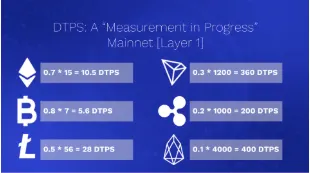
Here is a very hand-wavy sketch of what DTPS looks like before you add in Layer 2 throughput. With consideration for only the base trust layers, Bitcoin and Ethereum are maximally decentralized, but weak with respect to transactions per second.
DTPS Layer 1 + Layer 2
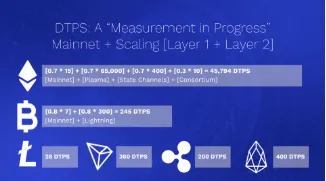
And here is a sketch of where we might be now with some Layer 2 throughput already on line.
The overall argument is this: The less decentralized a technology is, leading to smaller DTPS other things being equal, the less secure it is. Today’s global information infrastructure has a DTPS of, effectively, near-zero due to the centralized nature of the firms and technology that are performing the transactions, and the societal rules they are embedded in. This has led to the many data breaches, server hacks, and security issues we hear about regularly.
By establishing a base settlement layer on which many blockchain and related systems can ‘anchor’ their transactions, the DTPS of the ecosystem will skyrocket, and will grow with every sidechain or linked blockchain that is attached to that root-chain. The result is a diverse ecosystem of transaction processing, each perhaps uniquely suited for specific use cases, but all appropriately secure for their use case. And when Ethereum 2.0 comes online the capacity of the system will instantly grow one thousand fold.
Conclusion
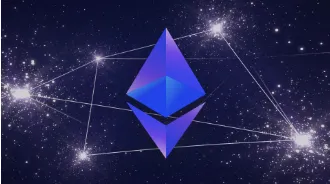
Open, shared platforms are natural. We live with them daily. The ground is a transportation layer that we can all walk on, the air we can all freely breathe, public parks enable us to gather and play together, and in oceans, lakes and rivers we can swim and fish for food. These are all common goods and we should strive to make as much of our digital infrastructure as possible a common good as well. The more value we can push down into lower protocol layers to be shared by everyone cheaply, the more value will accrue to society broadly.
And with the ability to create natively-digital value on base settlement layers that everyone can trust, we can move from cut-throat competitive, resource-constrained, zero-sum mindsets to positive-sum endeavours. Unconstrained, abundance mindsets will promote collaboration as a guiding principle for economic competition, eventually perhaps leading to the collaboration characteristic dominating the competition characteristic. Effective crypto-economic mechanism design will encourage us to root for one another to succeed, because if others on your open platform succeed, your fortunes will grow as well.
Thank you.

